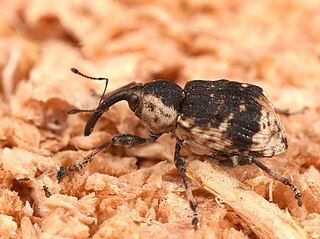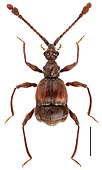
Paederus dermatitis, medically known as dermatitis linearis, is a skin irritation resulting from contact with the hemolymph of certain rove beetles, a group that belongs to the insect order Coleoptera and the genus Paederus. Other local names given to Paederus dermatitis include spider-lick, whiplash dermatitis, and Nairobi fly dermatitis.

Pentarthrum huttoni is a species of wood boring weevil in family Curculionidae. It has a mainly nearctic distribution, but has also been reported from several European countries. It was first reported in Austria in 2006 when it was found to be the cause of disintegration of historically significant 18th century softwood coffins in the crypt of St. Michael's church in the center of Vienna.

Staphylininae are a subfamily of rove beetles. They contain the typical rove beetles with their long but fairly robust blunt-headed and -tipped bodies and short elytra, as well as some more unusually-shaped lineages.

The Paederinae are a subfamily of the Staphylinidae, rove beetles. The Paederinae include two tribes, Paederini and Pinophilini. This insect is commonly known as Tomcat.

Paederus is a genus of small beetles of the family Staphylinidae. With 622 valid species assigned by 1987 to the subtribe Paederina, and with all but 148 within Paederus itself, the genus is large. Due to toxins in the hemolymph of some species within this genus, it has given its name to paederus dermatitis, a characteristic skin irritation that occurs if one of the insects is crushed against skin. That name, Paederus dermatitis, is a poor choice because, decades earlier, the affliction had been called dermatitis linearis, a name that works in all languages, not just English, because of its Latin origin; the name Paederus dermatitis is also inappropriate because it has shown to be caused by (a) only a few species of the genus Paederus, but (b) also a few species that belong to closely related genera within the subtribe Paederina. A scholarly paper in 2002 suggested that a Paederus species could have been responsible for some of the ten Plagues of Egypt described in the Bible's Book of Exodus.

Anastrangalia dubia is a species of beetle of family Cerambycidae.

Tillus elongatus is a species of beetle in the family of checkered beetles Cleridae. It is found in the Palearctic. The “Holz” in the German common name Holzbuntkäfer indicates that these checkered beetles are found in wood. Although Tillus elongatus can reach up to a size of 1 cm long, the beetle is rarely seen by humans, as it primarily resides hidden in the wood of trees. The colouration of the males differs from that of the females.

Liparus coronatus is a species of beetles belonging to the family Curculionidae.

Dryocoetes autographus is a species of weevil native to Europe.

Hylesinus fraxini is a species of weevil native to Europe.

Dryocoetes villosus is a species of weevil native to Europe.

Orthotomicus laricis, commonly known as the lesser larch bark beetle, is a species of weevil native to Europe.

Pityogenes bidentatus is a species of bark beetle native to Europe.

Trypodendron domesticum is a species of weevil native to Europe.

Grypus equiseti, known by the common name horsetail weevil, is a species of weevil native to Europe. It feeds on Equisetum arvense and Equisetum palustre plants. It has been introduced to New Zealand to control Equisetum arvense, which is an invasive species there.

Notaris acridulus is a species of weevil native to Europe.

Thryogenes nereis is a species of weevil native to Europe.

Tournotaris bimaculatus is a species of weevil native to Europe.

Ocypus nitens is a species of large rove beetle in the family Staphylinidae.

Coptocephala unifasciata is a species of leaf beetle belonging to the family Chrysomelidae, subfamily Cryptocephalinae.

























